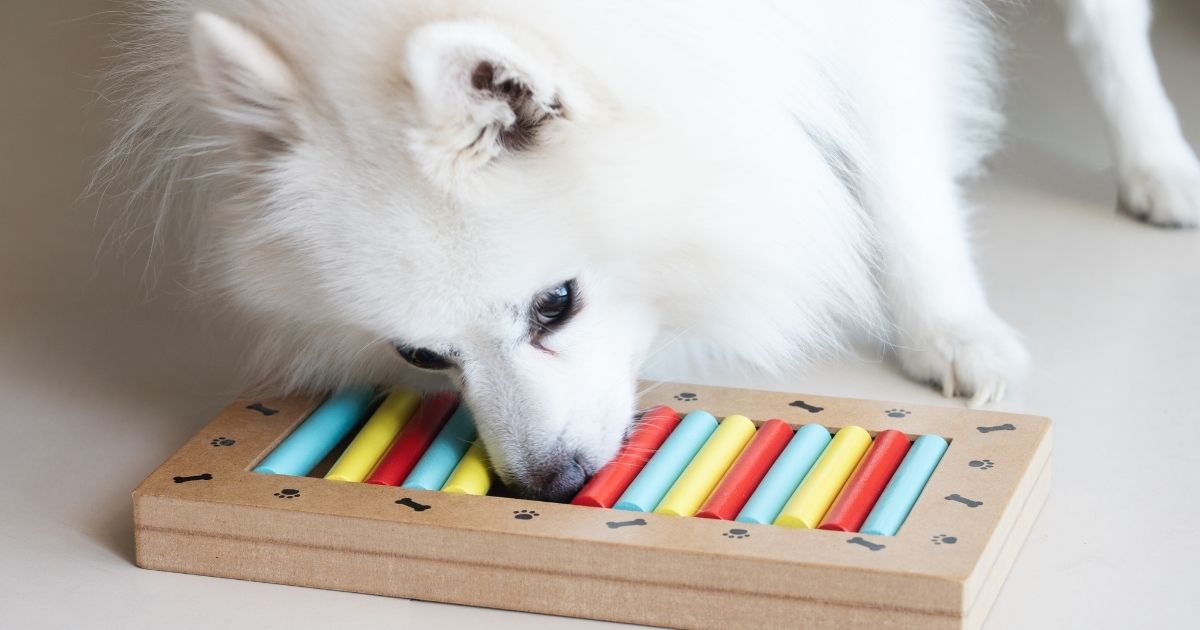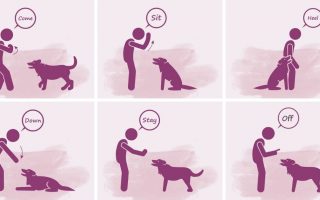We all know the benefits of physical exercises to dogs and how they should not be neglected, especially if you happen to own breeds like the Siberian Husky that is highly energetic.
Taking your pooch outdoors to use up that pent-up energy helps it stay rested afterward.
However, physical exercise is but one side of the coin. Providing mental stimulation for dogs is the other aspect.
Some dogs may not be satisfied with only sports, and there’s a limit to the activities you can do without injuring or overexerting your pet dog in the process.
But just like people train their minds with puzzles and quizzes, dogs are intelligent enough to have their minds exercised.
Not only is mental stimulation a form of training, but it is also an outlet to release energy.
Anyone who frequently does mental work can attest to the difficulty it poses.
Thus, why you draw up a physical exercise plan for your pooch, find ways to stimulate it mentally too.
The purpose of this guide is to help you with this task.
After explaining mental stimulation in dogs and detailing its importance, we’ll look into 10 surefire ways to provide mental stimulation for dogs.
What is Mental Stimulation for Dogs?
According to experts on the subject, mental stimulation, in general, refers to “anything that stimulates, activates or enriches the mind.”
It could either be internal (through contemplations and brainstorming) or external (mind games, puzzles, study).
That man sitting at the airport with a crossword puzzle and a pencil is stimulating his mind.
For dogs, the same definition applies. Mental stimulation is meant to work on the mind much as physical activities work on the muscles.
This contributes to the dog’s welfare in many ways.
As the American Kennel Club puts it, behavioral problems are easily curbed with enough mental stimulation.
Why is Mental Stimulation Important for Dogs?
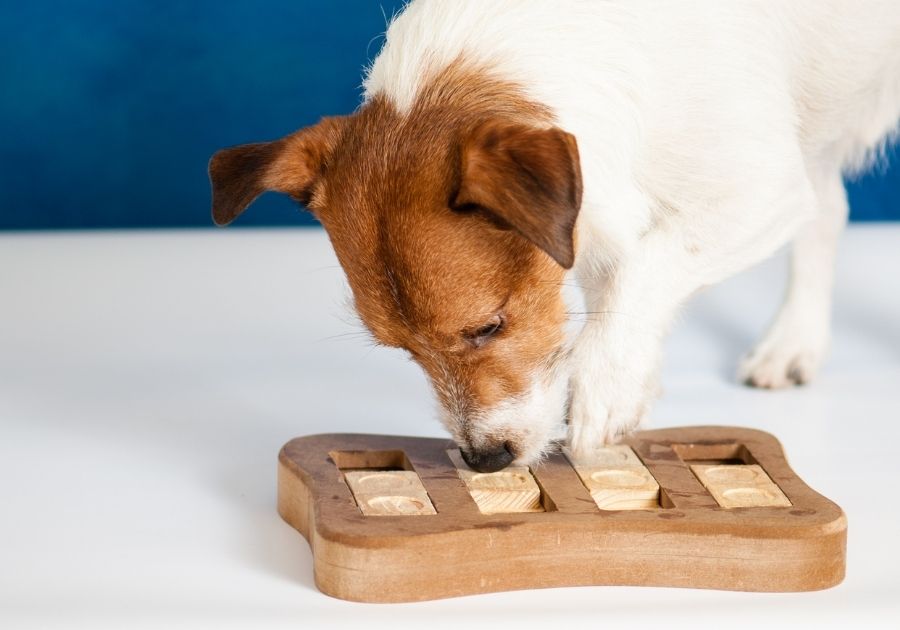
Drawing from the previous section, mental stimulation is a good preventive measure—and a cure—for behavioral problems.
Many pet parents have to deal with their pet dogs chewing through furniture, digging holes in the yard, barking till neighbors come ringing, and some other habits that are common amongst canines.
Sometimes, we assume these habits are normal and natural.
While they do stem out of instinct, they are usually developed, often because the dogs are not being stimulated enough.
Boredom and restlessness make these dogs resort to keeping themselves busy in the only ways they know.
When you provide more interesting alternatives, your pooch is more likely to abandon those other habits.
Overall, it is important to mentally stimulate your dog because:
- It makes dogs happy.
- It is a good form of training.
- It reduces hyperactivity and boredom.
- It curbs destructive behaviors.
- It provides opportunities for you and your pooch to bond.
- It is fun.
Bear in mind that dogs are intelligent, just as much as a toddler is.
According to a study done on dogs’ intelligence, it was discovered that they are as smart as a 2-year-old child.
Some others place the age at 3 to 5, but the consensus seems to be 2. It possibly depends on the breed as some are more intelligent than others.
Having said that, any dog breed can benefit from mental stimulation. We’ll be providing clarity with some surefire tips to get you started.
How to Provide Mental Stimulation for Dogs (10 Proven Ways)
1. Challenge your dog with an obstacle course
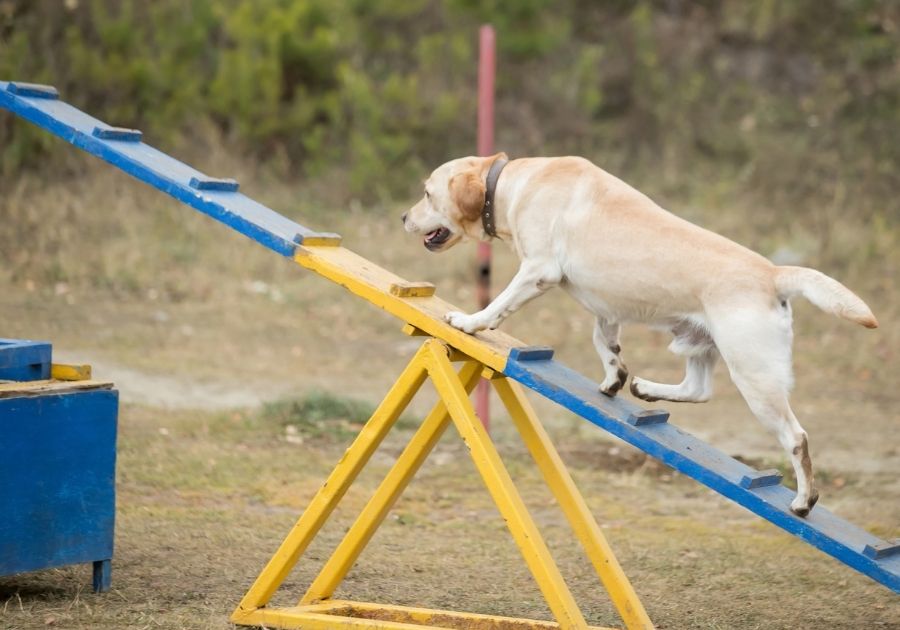
An obstacle course involves placing a series of physical obstacles that the player must move through to get to the finish line.
It is usually timed and can be a great way to work on both your dog’s agility and problem-solving skills. You get to shoot two birds with one stone.
Many owners opt to construct an obstacle course in their backyard. It requires being crafty.
Or, you can improvise by using objects at home like blankets, hazard cones, broomsticks, and toys.
If you would rather make yours, there are different DIY steps you can take. As we said, it requires craft, so ensure you have some handyman skills.
With the obstacle course in place, start training your pet dog to navigate through it with simple commands it can understand. That is where the mental work begins.
2. Get your dog’s nose working with some scent games
Scent games, also known as nose work games, works just as it sounds. It involves getting your dog to use its nose to locate something, a treat, or even a toy.
Dogs have a stronger sense of smell than humans, the reason they are employed to sniff out drugs, cadavers, and even bombs.
Scent games get dogs to use their natural nose skills rather than just depend on the eyes. This is quality training.
It also stimulates their minds as they have to concentrate on the task, and it offers extra physical activities.
This game is best done indoors to avoid distractions. Use an easy command that it can associate with the game, such as Find It or something more specific.
Place the treat or toy at a place where your dog can see, then repeat the command till it knows what you want it to do.
Slowly make the game more challenging by shifting the “treasure” further away.
3. How about some tricks?
Do you fancy entertaining visitors with some doggy tricks? Then you can add this to your mental stimulation routine.
Tricks are fun to teach, interesting for the dog to learn, and awesome when mastered.
Tricks are especially helpful for timid dogs as they can help them gain their confidence.
Other than that, it strengthens the bond between you and your dog, helps it focus, and also curb bad behaviors but replace them with good ones.
Other than the basic commands of Sit, Lie Down, Stay, Come, dogs can learn many other fanciful ones.
You can train your dog to wink, give a handshake, leap, and even dance.
Tricks shouldn’t be solely for fun, though. Some of them can be used to pull your dog out of a dangerous situation.
Teaching your dog to respond to its name is one essential trick.
Using treats, a clicker, and enough positive reinforcements will help you succeed in this.
4. Let your dog know the names of its favorite toys
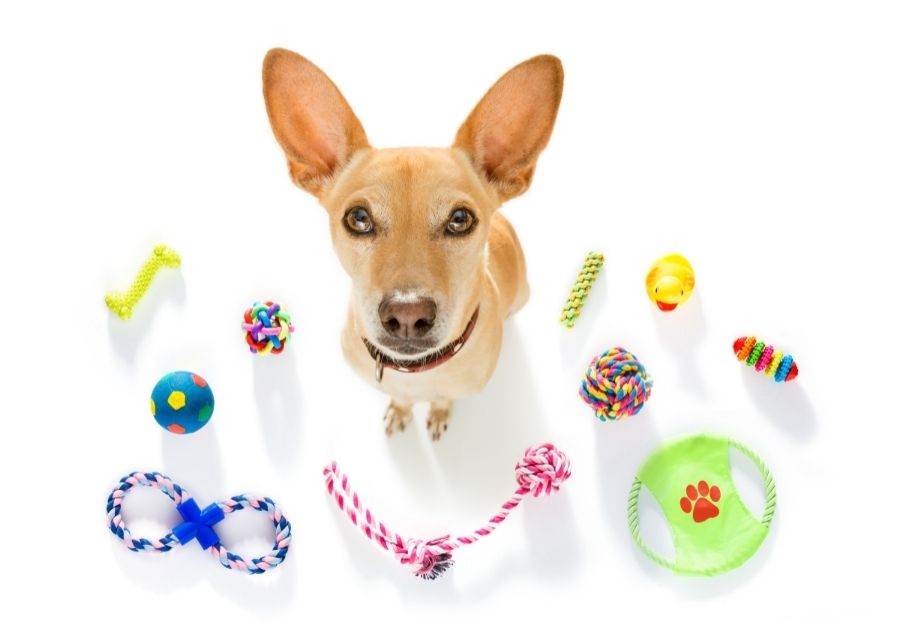
Like kids, many dogs love their toys. They might end up choosing some as their favorites.
You’d know which one is your dog’s favorite by determining which one it plays more with. Territorial breeds also tend to protect their favorites.
This mental game can be done together with scent games to make it more fun. Don’t try to go fast on this as that may get a dog confused.
Pick a particular toy that is your dog’s favorite, for instance ‘Brown Teddy’. Put the toy in front of the dog and repeat the name till it touches the toy.
Once it succeeds, reward it with a treat or praise. Keep repeating the game with the Brown Teddy till your dog recognizes the toy with ease.
Then, add another toy.
5. Don’t make it easy for them to get their food
Dogs are natural scavengers and know how to instinctively search for a meal as they used to do that in older times.
Modern household arrangements have made this instinct obsolete as owners simply hand over the bowl to the dog and let it have at the meal.
However, you can challenge your dog’s mind—and make feeding time more fun—by inventing an indoor scavenger game.
Just as it sounds, you get your dog to locate its meal. You can also opt for food dispensing toys for a different challenge.
You place the meal in the toy and get your dog to roll it around for the meal to be dispensed from the hole.
This would surely hold your dog’s interest for long.
6. Let your dog explore outdoors
This goes beyond taking the dog outside for physical activities like walking and jogging.
You should also let your dog use its senses to observe and explore its surroundings.
A good place to do this is at a secured dog park. You can let your dog go off-leash and relate with its environment.
During a normal walk, it is more advisable to keep your dog on a leash as that would stop curious ones from darting off in an opposite direction. Recall training helps too.
Besides walking, jogging, and a visit to the park, an activity that gives your dog a chance to connect to nature is hiking.
This isn’t suitable for all dog breeds, but energetic ones will appreciate the long trek.
Ensure you have all the necessities packed up before you move.
7. Try out shaping games
Shaping games come in many forms, but the main idea is to get your dog to make decisions without any verbal commands on your part.
The dog would have to use its mind to figure out what you want it to do, which is both challenging and fun.
An example of a shaping game is 101 things to do with a box, a game that was gotten from dolphin research but has since become a favorite of dog owners.
It involves using a clicker and treats to get your dog to go inside a box.
Another good shaping game is that of getting a dog to go under an object.
It is best to do this in a room with no other object except the one you want your dog to crawl under.
You also need a clicker and treats to achieve this. For a better perspective, watch this video:
8. Interactive play goes a long way
Unlike other mental games and training we’ve suggested, interactive play features you and the dog as active players.
You are not at the side while your dog goes through the training. Here, you are an integral part of the whole process.
Interactive games help dogs in more ways than we even realize.
Just as parents are advised to play with their children, pet parents should engage in games with their dogs.
This not only helps with bonding, but it also improves your dog’s confidence, keeps them mentally healthy, keeps them strong, and even helps with anxiety.
Experts have confirmed that playtime is vital for a dog’s wellbeing.
Some examples of interactive play include fetch, frisbee toss, tug of war, hide and seek, and even a friendly game of soccer.
9. Try out shell games
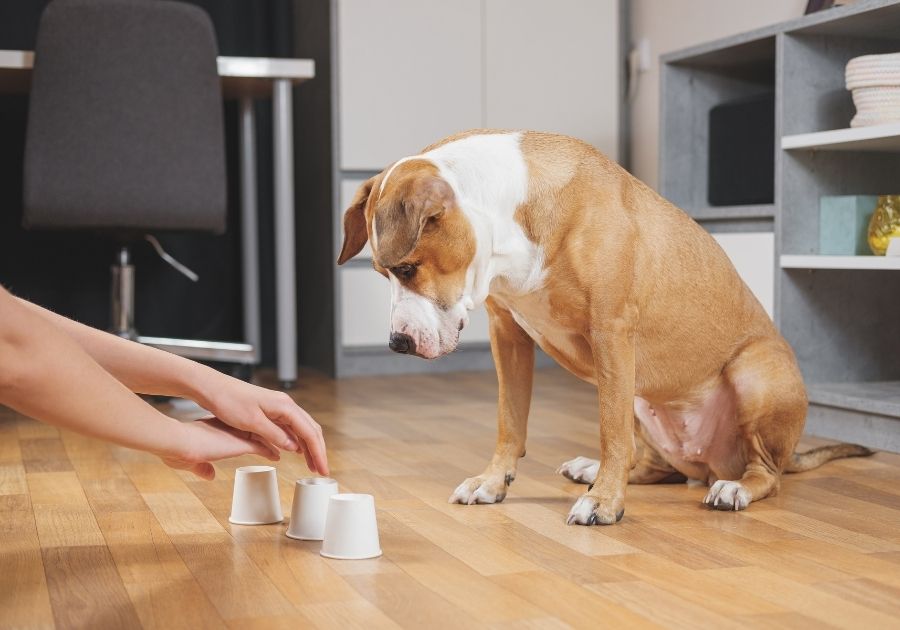
If this is the first time you’re hearing of this, no, it has nothing to do with seashells.
Shell game involves placing a treat under three similar bowls or containers then shuffling them as fast as you can while the dog watches.
After some seconds, stop and let it pick which bowl might be concealing the treat.
If it wins, the treat is a prize. If it doesn’t, you try again.
This game is a strong mental game as it pushes your dog to think (as much as a dog can think), and also develop its problem-solving skills.
With enough practice, they should be able to record more wins than losses, but don’t be discouraged if your dog keeps failing at first.
10. Challenge its mind with puzzles
A puzzle is the first game most people think about when it comes to mental stimulation, and it isn’t hard to see why.
A very challenging mental game, puzzles train the brain of both humans and dogs.
Puzzles are appreciated more by worker dogs turned companions who love having a job to do.
It keeps them busier than a game of fetch (which may get boring fast), a feat that keeps them happier and less likely to get antsy.
Puzzles help a lot when your energetic dog can’t be taken outdoors for exercise, like when it is raining.
How Do I Know if My Dog Needs More Mental Stimulation?

Having known different ways you can mentally stimulate your dog, you should also learn how to detect when your dog needs some mental work.
The signs could show that it is bored, restless, tired, or just understimulated.
When you notice these signs, it is normal to think of physical exercise first. However, remember that you shouldn’t limit yourself to that.
Mental work helps calm your dog and keep it interested just as much as physical activities. They can also go hand in hand, as we’ve seen.
The common signs that your dog needs mental stimulation are explained below:
1. It can’t seem to stay still
This can happen even after physical exercise. Your dog sits, stands, moves around, and keeps repeating those gestures.
You’ll know your dog is sufficiently exercised (mentally and physically) when it remains calm.
2. It constantly chews on everything
This is a very common sign that your dog is bored and trying to keep itself busy. Your pooch can get destructive if you don’t intervene in time.
3. Excessive barking
It’s one thing for your dog to bark because it sighted a stranger or something foreign.
But if it keeps barking constantly, it is undesirable behavior. Good training and consistent activities can help reduce this.
4. Digging
This habit is more prominent in some breeds than others. There are also many reasons a dog keeps digging, and that includes restlessness.
Watch out for any frantic motions while it digs. That would show you that you need to keep it busy.
5. Sleeping
A lot of us are guilty of sleeping when bored so the day can fly by. Dogs possibly use the same logic.
So, sleeping may not always mean that the dog is satisfied. It could just mean that it needs to step out or play some games.
Lazy dog breeds do this more when they are bored.
6. Whining
Whining could mean a lot of things. That your dog is in pain, sad, hungry, in need of attention, or plain bored.
The best way to know is by waiting for it to stop, then providing something to keep it busy (like a chew toy).
If it persists, then the problem might be more than boredom.
Commonly Asked Questions
How much mental stimulation does a dog need?
There is no hard rule to these things, but generally, dogs get at least 20 to 30 minutes of mental stimulation a day.
Some breeds need more than others. That’s up to you to determine.
Is chewing mentally stimulating for dogs?
Chewing requires a lot of focus, which engages the mind. Therefore, while it works on the jaws, chewing is also mentally stimulating for dogs.
It is advisable to get some chew toys and keep them close by.
How do you mentally stimulate your dog when you’re not home?
It can be tough to decide how to keep your dog mentally stimulated when you’re busy or away, but fortunately, there are different options you can choose from.
An interactive toy is an option, or you can enroll your dog in a Daycare if it can handle it. Hiring an experienced dog sitter works too.
Are walks mentally stimulating for dogs?
During walks, dogs can get mentally stimulated if they are allowed to explore and sniff around the pathway.
Keep them leashed to stop them from scampering off.
Are car rides mental stimulation for dogs?
A car ride is an easy and efficient way to mentally stimulate your dog. It gets exposed to new places, smells, and sights, which engages its mind.
Bottom Line: A Mentally Stimulated Dog is a Happy Dog
If there’s a key takeaway you should never forget, it is that all dogs need to be mentally stimulated.
From toy breeds to ex-hunting dogs, find time to engage their minds and teach them new things.
The benefits of mental exercises for dogs are too many for it to be neglected.
If you know any other mental games that can help but aren’t included in our list, feel free to use our comment section and educate everyone.

